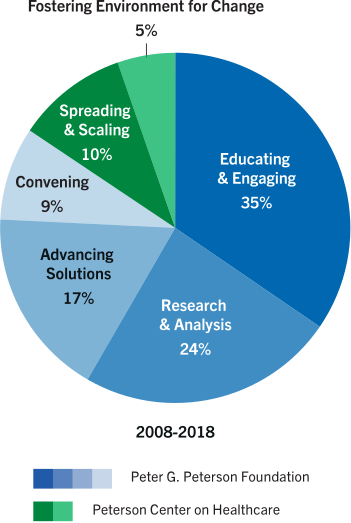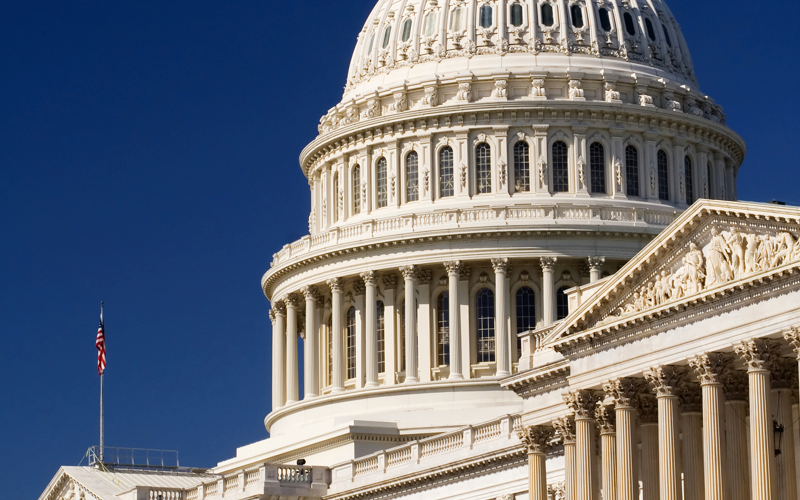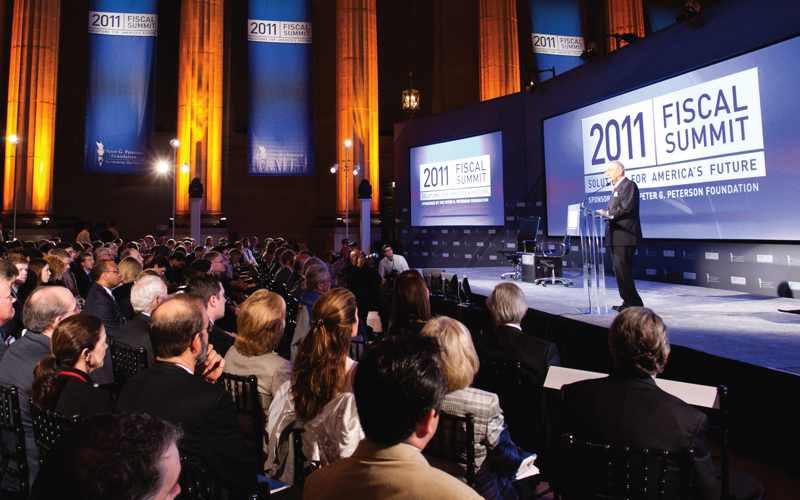PETER G. PETERSON FOUNDATION Ten Year Report
Letter
In 2008, the Peter G. Peterson Foundation was established with the goal of preserving the American Dream for the next generation. My father saw our high and rising debt as a transcendent threat to our future economy — posing a risk to every American, and our leadership role in the world.
As we look back on the first decade of our work, our impact and reach have grown, but the challenge remains. And our commitment has never been stronger.
The United States’ fiscal challenge is the most predictable crisis in history. That’s because it is driven by entirely foreseeable trends: a large baby boom generation that is living longer, relying on the most expensive and inefficient healthcare system in the world, combined with a tax code that fails to generate sufficient revenue to pay for what we have promised our citizens. Put these factors together, and you are left with a nation in an unsustainable position, forced to borrow from its future to fund its present.
How does the Foundation make progress on such an important and complex problem? We bring people and ideas together. We are a convener, a consensus builder, a solutions finder, and a trusted resource for policymakers and citizens. We educate and engage millions of Americans to increase awareness and accelerate action on our growing national debt, through a deep portfolio of activities, partnerships and grants. Our work includes timely research and analysis, innovative and multi-faceted campaigns, and coalition-building to advance policy solutions and gather diverse voices from across the political spectrum and across America.
Further, recognizing that healthcare performance plays an essential role in defining America’s fiscal outlook and future economy, our Foundation has built a dedicated effort focused on improving the delivery of care. In 2014, we launched the Peterson Center on Healthcare, which is working to transform U.S. healthcare into a high-performance system by finding, validating and accelerating the adoption of proven solutions that improve quality and lower the cost of care.
Addressing our nation’s fiscal outlook has never been more urgent. At $22 trillion, the national debt is already dangerously high. This year our federal budget deficit is projected to add nearly $1 trillion more to the debt. Worse yet, we have just entered an era in which, absent policy changes, our daunting demographics will grow the deficit every single year as far as the eye can see. This is the definition of unsustainable.
And the result of this irresponsible path can easily be seen in our nation’s fastest growing government “program”: interest costs. Over the next ten years, we will spend a staggering $7 trillion in interest costs. Next year we will spend more on interest than we do our kids. A few years after that, interest costs will exceed what we spend on national defense. To maintain our strength as a nation, we simply can’t spend more on our past than on our future.
Why does it matter? Because our high and rising debt does real damage to our future, reducing capital for public and private investment, endangering our flexibility to deal with crises or emergencies, weakening the safety net, and diminishing economic opportunities for Americans. Put simply, our fiscal outlook has negative ramifications for Americans from every state, generation and political party.
Unfortunately, hyper-partisanship in Washington continues to stand in the way of meaningful progress on these non-partisan realities. In fact, recent tax and spending legislation have added trillions more in red ink, only making matters worse. The sooner we address these challenges, the easier the task will be.
Sadly, my father passed away in 2018 at the age of 91. I will be forever grateful for having him as a role model, and for the opportunity to work alongside him at the Foundation over the past decade. His spirit, energy and tenacity continue to inspire us every day.
My father and I built an organization that is poised for growth, and the first ten years of the Peterson Foundation are just the beginning. To meet the magnitude of these critical challenges, our resources, commitment and impact will expand significantly in the years ahead, as we strive for a more secure and prosperous economy with widely-shared opportunity. Our nation’s future is at stake, and our kids and grandkids deserve better.
With a dedicated staff and committed partners, we are just getting started in our mission to restore the American dream that my father was so fortunate to have lived.

Chairman and Chief Executive Officer
Our Founder

Peter G. Peterson
We have a moral obligation to future generations to build a dynamic, growing American economy that is defined by opportunity, mobility and prosperity.
Pete Peterson traced the roots of his character and work ethic back to his birthplace of Kearney, Nebraska. A first-generation American, Pete was born during the Great Depression to Greek immigrant parents who arrived in this country with little education, only a few words of English, and just pennies in their pockets.
His family operated the quintessential Greek diner — the Central Café — which stayed open for literally 24 hours a day, 365 days a year, for 25 straight years. This example taught Pete important lessons about the value of hard work, responsibility and, importantly, saving for the future.
These lessons stayed with Pete throughout his life, driving his passion to ensure that future generations have the same opportunity to live the American Dream that he did. He saw the rapidly growing national debt as a threat to opportunity, and with good reason.

Across Pete’s distinguished and far-reaching career — which included significant accomplishments across public service, business and philanthropy — he was a relentless advocate for fiscal responsibility. An author of eight books and dozens of articles, as well as a frequent public speaker, Pete committed himself to educating and persuading voters and policymakers alike about the need to recognize and prepare for America’s coming demographic challenges.
At a fundamental level, Pete saw the nation’s fiscal outlook as a threat to the long-term future of America. In 2008, Pete launched the Peter G. Peterson Foundation because, he said, “nothing less than the American Dream itself was at stake.”
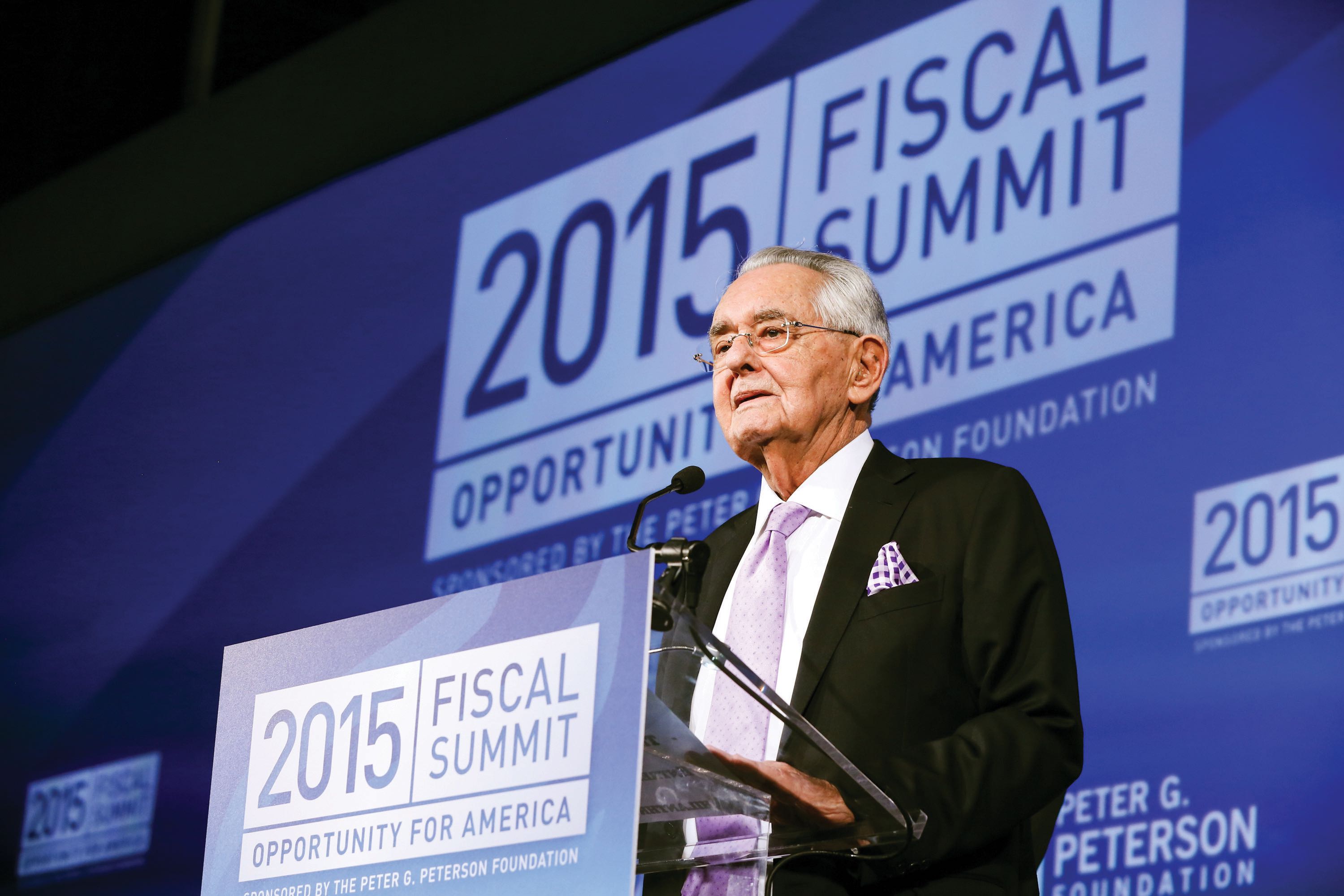
"I started the Peter G. Peterson foundation to engage with people all across America — policymakers, budget experts, business leaders, academics and citizens of every generation … frankly, anyone who will listen.”
State of Fiscal
The United States is on an unsustainable and dangerous fiscal path. Our nation’s debt is at historically high levels and projected to rise dramatically, posing a significant risk to our economy and to every American’s future.
Our debt challenge isn’t based on politics or partisanship — it’s the simple math of spending more than we take in. America has 73 million baby boomers retiring and living longer, a highly inefficient healthcare system, and a tax code that fails to generate sufficient revenues. These factors combine to pose real threats to our future, from lower productivity and reduced public and private investment to a higher likelihood of fiscal crises, weakening of our safety net, and diminishing economic opportunities for Americans.
In 2018, gross federal debt exceeded $21 trillion, by far an all-time high. Budget deficits will soon exceed $1 trillion per year, and over the next decade we are on pace to add $12.4 trillion to the national debt. As a share of gross domestic product (GDP), debt held by the public has already reached its highest level since 1950, and it is on pace to nearly equal the size of our entire economy by 2028. Deficits and debt are projected to increase rapidly in the future, with no end in sight.
Debt Held by the Public (% of GDP)

SOURCE: Congressional Budget Office, The 2018 Long-Term Budget Outlook, June 2018. Compiled by PGPF.
Throughout American history, national emergencies including wars and economic downturns have had significant short-term impacts on our fiscal condition. Events like the Great Depression, World War II and the 2008 financial crisis, for example, all caused deficits to rise temporarily.
Today’s fiscal situation is different. Debt and deficits are rising, but not in response to an emergency or a temporary economic downturn. Instead, our fiscal challenges stem from a built-in, structural mismatch between spending and revenues.
This mismatch is caused by a mix of predictable drivers, including demographic trends and high healthcare costs combined with an inadequate revenue base for the spending policies that we have enacted, all of which is exacerbated by compounding debt and interest costs. Adding to the problem, in 2017 and 2018, lawmakers passed fiscally irresponsible tax and spending measures that made our nation’s fiscal outlook considerably worse — adding more than $2 trillion in new debt over the next 10 years.
Federal Revenues and Spending (% of GDP)

SOURCE: Congressional Budget Office, The 2018 Long-Term Budget Outlook, June 2018, and The Budget and Economic Outlook: 2018 to 2028, April 2018; and PGPF calculations based on CBO data. Compiled by PGPF.
Federal Spending (% of GDP)
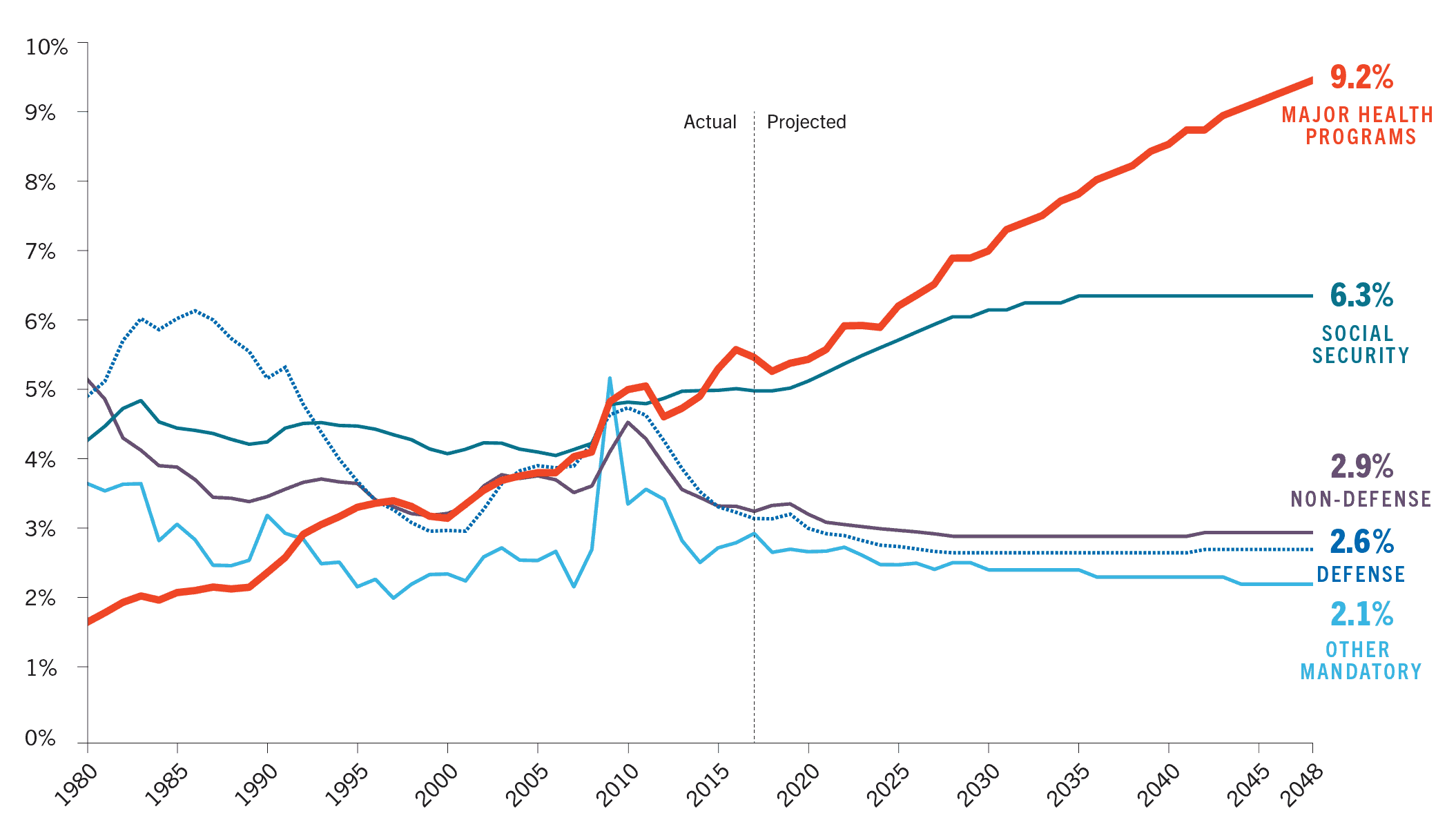
SOURCE: Congressional Budget Office, The 2018 Long-Term Budget Outlook, June 2018, and The Budget and Economic Outlook: 2018 to 2028, April 2018; and PGPF calculations based on CBO data. Compiled by PGPF.
Federal Spending (% of GDP)

SOURCE: Office of Management and Budget, Budget of the United States Government, Fiscal Year 2019, February 2018; Congressional Budget Office, The 2018 Long-Term Budget Outlook, June 2018. Compiled by PGPF.
NOTE: Infrastructure excludes defense.
Federal Interest Costs (Billions)

SOURCE: Congressional Budget Office, An Analysis of the President’s 2019 Budget, May 2018, and The Budget and Economic Outlook: 2018 to 2028, April 2018. Compiled by PGPF.
Key Drivers of Debt
Why Debt Matters
The Path Forward
Our Work
Building a vibrant American economy requires a strong fiscal foundation. Since 2008, the Peterson Foundation has worked to increase awareness of America’s key fiscal challenges and to advance solutions that put our nation on a more sustainable fiscal path.
As a non-partisan and non-profit organization, we work across party lines with policy experts, elected leaders and the general public. Our mission is to bring people together around a shared vision for a strong and sustainable fiscal and economic future with rising incomes, abundant opportunities and widely-shared prosperity for the next generation.
The Foundation undertakes a range of activities, partnerships and grants to educate and engage our nation’s leaders and the public in order to secure a better fiscal and economic path forward.
Research & Analysis
To help explain the fiscal challenge itself and illuminate the way forward, we produce timely research and analyses, adding depth and insight to the policy conversation.
Educating & Engaging
We inspire and empower Americans with innovative campaigns that increase awareness, mobilize young people and drive a thoughtful national dialogue around sustainable fiscal and economic policies.
Advancing Solutions
America’s fiscal challenges are serious, but they are also solvable. We build bipartisan coalitions to develop and advance common sense solutions that cut through entrenched partisan lines.
Convening
We provide a platform for leading thinkers and policymakers to have constructive, substantive discussions — including through our signature annual event, the Fiscal Summit.
Peterson Center on Healthcare
In many ways, healthcare represents the single greatest issue for our nation’s fiscal and economic future. To make meaningful progress on America’s fiscal outlook and build a growing economy, we must address the performance of the U.S. healthcare delivery system.
From a federal budget standpoint, healthcare is far and away the key driver of spending. In fact, healthcare accounts for approximately 70% of the growth in federal mandatory spending over the long term.
Moreover, healthcare presents its own major economic challenge, as rising healthcare costs lower wages, hurt competitiveness, and threaten our ability to invest in education and other critical drivers of a prosperous future.
High Performance Healthcare
There are already many great examples of high-performance care — we just need to replicate them. Rather than serving as an inventor of new approaches, we seek what already works. We focus on finding, validating and scaling models proven to deliver higher-quality care and lower costs.
Fostering an Environment for Improvement
Recognizing that context matters, we focus on a broad portfolio of work to improve the environment for productive, lasting change — including monitoring performance more closely, increasing data transparency and building coalitions of key stakeholders.
About Us
The Peter G. Peterson Foundation is a non-profit, non-partisan organization that is dedicated to increasing public awareness of the nature and urgency of key fiscal challenges threatening America's future, and to accelerating action on them. To address these challenges successfully, we work to bring Americans together to find and implement sensible, long-term solutions that transcend age, party lines and ideological divides in order to achieve real results.
Financials
In 2008, Pete Peterson established the Foundation with a $1 billion commitment to help make the American Dream available to every citizen. Since its inception, Foundation program expenditures have focused on three primary areas: grants and grantmaking; education, engagement and awareness; and policy research and analysis. The Foundation has consistently worked alongside trusted partners, as well as through our own initiatives and research, to raise awareness of our nation’s fiscal challenges, spur action and advance solutions.
In 2014, the Foundation established the Peterson Center on Healthcare with an initial $200 million commitment, with the mission to make higher-quality, more affordable healthcare a reality for all Americans.
As of March 31, 2018, the Foundation’s unrestricted assets totaled $873 million. From 2008 to 2018, the Foundation’s total expenditures were $253.9 million, including $219.6 million in program expenditures and $34.3 million in supporting services.¹
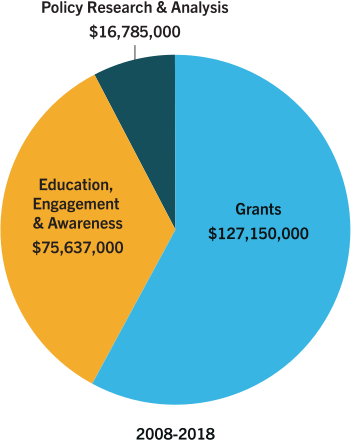
¹ The Foundation’s fiscal year ends March 31. Annual financial statements for FY 2016 — 2018 were audited by KPMG. Annual financial statements for FY 2009 — 2015 were audited by Mitchell & Titus, LLP, a member firm of Ernst & Young Global Limited. Supporting services includes human resources, legal, accounting and other administrative expenses.
